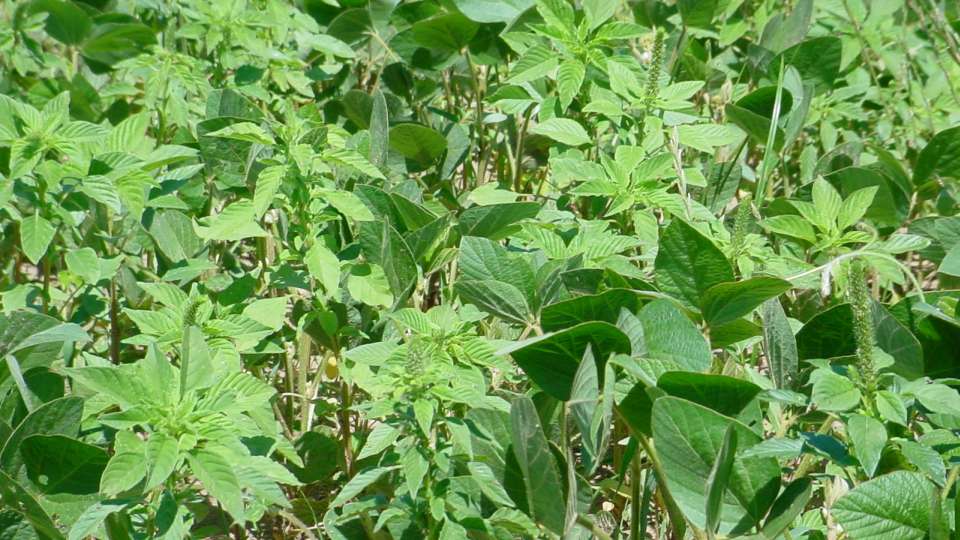WSSA Survey: Palmer Amaranth Ranked The Most Troublesome Weed In The U.S.

A single Palmer amaranth plant can produce as many as a million seeds during a growing season.
It’s now official. A survey conducted by the Weed Science Society of America (WSSA) has ranked Palmer amaranth, also known as Palmer pigweed, as the most troublesome weed in the U.S. Weeds in the Galium genus (cleavers, catchweed bedstraw, and false cleavers) ranked as the most troublesome in Canada.
“We certainly weren’t surprised to find Palmer amaranth at the top of the U.S. list,” says Lee Van Wychen, Ph.D., science policy director for WSSA. “This weed can have a devastating impact on crop yields. Its stems are tough enough to damage rugged farm equipment, and it is extremely prolific. A single Palmer amaranth plant can produce as many as a million seeds during a growing season.”
Hundreds of weed scientists, extension agents and practitioners across 49 U.S. states, Puerto Rico, and eight Canadian provinces participated in the 2015 WSSA survey. They provided input on both the most common weeds (those most frequently seen) and the most troublesome weeds (those most difficult to control) in 26 different cropping systems and natural areas. The lists below are based on an aggregation of their responses, which mentioned more than 650 weeds at least once.
| Most Troublesome Weeds, U.S | Most Common Weeds, U.S. |
|---|---|
| 1. Palmer amaranth | 1. foxtail (giant, green, yellow) |
| 2. morningglory (ivyleaf, pitted, tall, sharppod) | 2. common lambsquarters |
| 3. common lambsquarters | 3. crabgrass (large, smooth) |
| 4. waterhemp (common, tall) | 4. Palmer amaranth |
| 5. horseweed (marestail) | 5. morningglory (ivyleaf, pitted, tall, sharppod) |
Three weeds – common lambsquarters, morningglory species, and Palmer amaranth – appear on both lists above.
For Canada, weed species in the Alberta, Saskatchewan and Manitoba prairies tended to dominate the survey. Wild buckwheat and wild oat appeared on both the “most troublesome” and “most common” lists.
| Most Troublesome Weeds, Canada | Most Common Weeds, canada |
|---|---|
| 1. Galium (cleavers, catchweed, bedstraw, false cleavers) | 1. wild buckwheat |
| 2. wild oat | 2. wild oat |
| 3. Canada thistle | 3. pigweed (redroot, smooth) |
| 4. kochia | 4. foxtails (green, yellow, giant) |
| 5. wild buckwheat | 5. common lambsquarters |
Among the other significant findings from the 2015 WSSA survey were the most troublesome and the most common weeds in several key crops and ecosystems across the U.S. and Canada:
| Crop/Ecosystem | Most Troublesome Weed | Most Common Weed |
| Aquatic systems | hydrilla | watermifoil (Eurasian, hybrid) |
| Cereal grains, spring | wild oat | wild oat |
| Cereal grains, winter | downy brome/cheatgrass | downy brome/cheatgrass |
| Corn | waterhemp (common, tall) | foxtail (giant, green, yellow) |
| Cotton | Palmer amaranth | Palmer amaranth |
| Parks, wildlife refuges | Canada thistle | downy brome/cheatgrass |
| Forestry | Japanese stiltgrass (Mary’s grass, Nepalese browntop) | Japanese stiltgrass (Mary’s grass, Nepalese browntop) |
| Fruit and nut crops | Eastern poison ivy | red sorrel |
| Pastures, rangelands, right of ways | Canada thistle | Canada thistle |
| Soybean | horseweed (marestail) | foxtail (giant, green, yellow) |
| Turf | annual bluegrass | crabgrass (large, smooth) |
| Vegetables | nutsedge (yellow, purple) | common lambsquarters |
The 2015 survey data is available here. Scientific names for the weeds above are available in the WSSA composite list of weeds.
WSSA plans to conduct its weed survey annually, with a three-year rotation of different weed habitats. The 2016 survey focuses on weeds in broadleaf crops, fruits, and vegetables. The 2017 survey will focus on weeds in grass crops, pastureland, and turf, while the 2018 survey will focus on weeds in aquatic environments, natural areas, and other noncrop settings.






